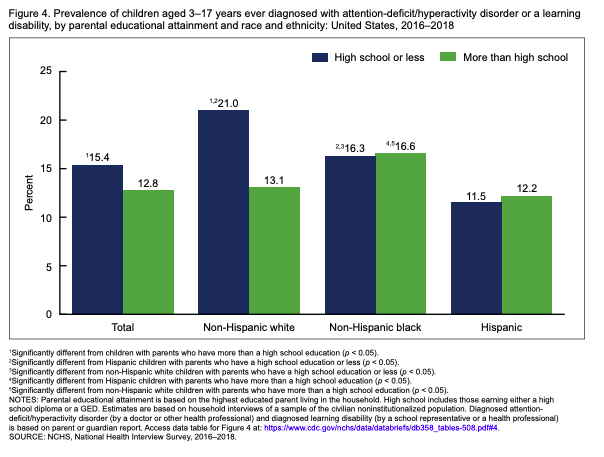ADHD and Learning Disability Diagnosis Rates In the U.S.
About one in seven children aged 3 to 17 in the United States have been diagnosed with ADHD (attention deficit hyperactivity disorder) or a learning disability. There are racial and ethnic disparities in ADHD and learning disability diagnosis rates in the U.S., but they are smaller than many people believe them to be, and are different than many people believe them to be.
Black kids are diagnosed about 15% more often than white kids, while Hispanic kids are diagnosed about 19% less often than white kids.
Kids from households in poverty are more likely to be diagnosed than those who are not, with the difference being especially great for white kids, who are 80% more likely to be diagnosed if they are poor than if they are not poor (compared to 33% for black kids and 29% for Hispanic kids).
Black and Hispanic kids are slightly less likely to be diagnosed if the mostly highly educated parent in their household has no education beyond high school (-2% and -6% respectively). White kids are much more likely to be diagnosed (+60%) if the mostly highly educated parent in their household has no education beyond high school.
Analysis
The Question And The Metaquestion
To figure out why the disparities are present, we have to consider two factors.
First, are some kids more likely to be diagnosed than others, despite having the same symptoms, and if so, why? The diagnosis of ADHD and learning disabilities is a mix of art and science and the accuracy of such a diagnosis is hard to determine objectively and with precision.
Second, if there are genuinely different rate of prevalence between subgroups, why is that the case?
Hypotheses
For example, the higher overall rate of diagnosis for black kids could be due to cultural differences being misinterpreted by teachers and psychologists as ADHD or a learning disability, or could be due to actual differences in prevalence rates (e.g. due to higher rates of lead exposure at home).
The lower rate of overall diagnosis for Hispanic kids could be due to language issues masking issues that are actually ADHD or a learning disability. But, it could also be an instance of the "fit immigrant" hypothesis at work, in which people who choose to emigrate from their home country are, on average, over a broad range of measures, more fit than those who stay at home, and parental fitness may in turn lead to greater child fitness since ADHD and learning disabilities have significant hereditary components. It could even be that actual rates are lower, but the conditions are over diagnosed for cultural reasons.
Higher rates of diagnosis for poor kids could be due to actually higher rates due to hereditary factors, since parents who had ADHD or learning disabilities are more likely to be poor than those who lack them.
But, the very high rates of diagnosis for white kids who are poor or who have parents who have no more than a high school education, relative to those who are not poor and/or have more educated parents, also suggests that teachers and psychologists see poor performance in white kids as due to a cause like ADHD or a learning disability, because they have higher expectations for those kids (whose co-ethnic peers are less likely to be poor or to have parents whose highly level of educational achievement is high school only), while they may see black or Hispanic kids who have behavior issues or trouble in school as merely "normal" because they have lower expectations for them. This could be true independent of whether ADHD and learning disabilities are over or under diagnosed. It could be that almost all white kids but only some non-white kids with these conditions are diagnosed, or it could be that lots of the white kids who are diagnosed have been inaccurately given a diagnosis that actually has some other cause.
The fact that diagnosis rates differ very little based on parental education for black and Hispanic children, and not by all that much across racial lines, could be seen as evidence that prevalence rates are pretty similar in all groups and that diagnosis rates mostly reflect that except for poor white kids and white kids in less educated households who may be over-diagnosed.
There is no statistical indication that more educated parents are pushing hard to have children who otherwise wouldn't be diagnosed tagged as having ADHD or a learning disability. But, even that can't be adequately resolved without knowing how much of the statistical differences are due to diagnosis rates relative to actually symptoms and how much of the differences are due to true differences in prevalence. My intuition from life experience is that children of more educated parents have lower incidences of actual ADHD and learning disabilities, but higher rates of diagnosis.
More information beyond these statistics is necessary to resolve these questions.
The data from the U.S. Center For Disease Control (CDC) can be summarized in the following two charts:




No comments:
Post a Comment